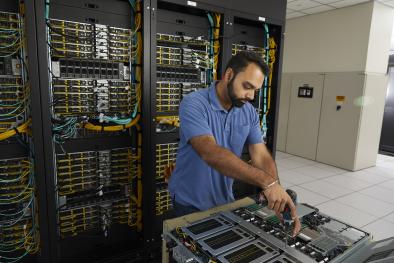When the COVID-19 pandemic began, the Laboratory immediately started seeking solutions to the myriad challenges posed by the global crisis. The Computing Directorate jumped right in with research and development (R&D) activities that combine molecular screening to inform antiviral drug experimentation; a generative molecular design (GMD) software platform to optimize properties of antiviral drugs; an online portal housing predicted viral protein–drug interactions and other data; and processor, memory, and storage upgrades to the computing systems that power these projects.
Computing staff also embarked on extensive operational adaptations including cyber security protections and scalable information technology to accommodate the large and suddenly remote portion of the Laboratory workforce, as well as support for viral contact tracing, online testing, and regulatory reporting. (See COVID-19 Operations.)
Applying LLNL’s unique talents and capabilities in the fight against COVID-19 is scientifically and technologically complicated. A multidisciplinary workforce is central to these activities, and Computing’s R&D teams frequently draw from multiple areas of the Laboratory.
“Collaboration is essential and gives us a chance to do something state-of-the-art,” says drug design project lead Jonathan Allen. Felice Lightstone, group leader for Biochemical and Biophysical Systems in LLNL’s Physical and Life Sciences Directorate, adds, “We couldn’t do it any other way.”
Essential Investments
Whether the task is pathogen detection, drug design, or any of the Laboratory’s many biosecurity projects, learning from the past informs the future. “When the pandemic hit, we knew we could respond with tools we’d been developing and workflows we had in place,” explains Marisa Torres.
These cumulative COVID-19 projects are possible thanks to a combination of funding sources, particularly within the Department of Energy (DOE) and National Nuclear Security Administration (NNSA). In the spring of 2020, the Laboratory received funds from the U.S. Coronavirus Aid, Relief, and Economic Security (CARES) Act, some of which were channeled to Computing.
The interwoven drug screen, GMD, and data portal efforts described here are funded by LLNL’s Laboratory Directed Research and Development (LDRD) Program, the DOE’s National Virtual Biotechnology Laboratory (NVBL), the ATOM consortium, the Department of Defense’s Defense Threat Reduction Agency (DTRA), the Defense Advanced Research Projects Agency (DARPA), and collaborators from other national laboratories.
Hardware upgrades were funded by the CARES Act and DOE’s Advanced Scientific Computing Research (ASCR) Program. NNSA’s Advanced Simulation and Computing (ASC) Program and LLNL’s Multiprogrammatic and Institutional Computing (M&IC) Program provided researchers with extra compute cycles. Industry partners also contributed to the cause.
For instance, AMD donated additional graphics processing units (GPUs) to the coincidentally named Corona supercomputing cluster; Intel, Supermicro, and Cornelis Networks aided in swift deployment of the Ruby cluster; and NVIDIA was instrumental in optimizing GPU performance on Sierra during the past year.


